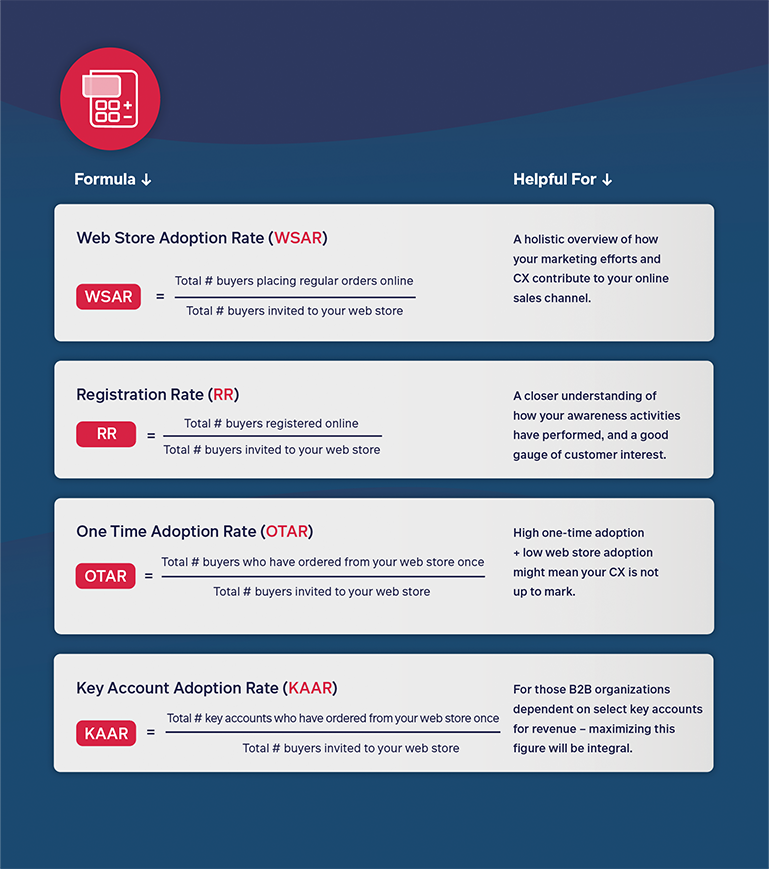

Key performance indicators (KPIs) can give you insights into every aspect of your business operations. B2B e-commerce KPIs allow you to track how your business is performing at any point in time. These metrics help you to identify targets to aim for, track progress milestones, and uncover problem areas. Analyzing B2B e-commerce KPIs enables stakeholders to make informed decisions to drive growth and keep the business on the path to sustained profitability.
Larger enterprises can have numerous KPIs covering departments, teams, and the business. So, if you’re an SME or an entrepreneur, it can be difficult to know exactly what KPIs you should be focusing on. Ideally, you should be concentrating on SMART KPIs – KPIs that are specific, measurable, achievable, relevant, and time-bound. SMART KPIs give you a clear, measurable, and actionable framework for tracking progress toward specific objectives.
We’ve taken a close look at the five most important SMART KPIs every online B2B web store should be tracking.
The top 5 KPIs for B2B web stores
How much do you know about your business operations on a granular level? Are you on track to meet your goals? Are you allocating your resources in the most efficient way possible? Are your customers satisfied with your business? How much does it cost you to acquire new customers and what’s their average spend over their lifetime? Knowing the answer to these questions can help you maximize your efficiency during boom times and economize during downturns.
While each business has its own unique goals, methods, and issues, monitoring five main KPIs are critical to ongoing success:
- Customer acquisition cost (CAC): The expenditure incurred by the business to gain a new customer.
- Average order value (AOV): The typical amount customers spend per transaction.
- Customer lifetime value (CLTV): The total revenue a customer contributes to the business throughout their entire association.
- Conversion rate: The proportion of website visitors who convert into paying customers.
- Cart abandonment rate: The percentage of customers who add items to their virtual shopping cart but fail to finalize the purchase.
Why these KPIs matter for your business
No matter the size, scope, or type of business you’re operating, you need to know how effective your marketing is, how your customers behave, and exactly how your business generates revenue. Each of the above KPIs can be tied to specific business goals to monitor progress. They are also quantifiable and measurable, so they provide you with reliable and actionable data. Tracking these KPIs can reveal valuable insights into how your customers feel about your business and their overall satisfaction and engagement with your products or services.
How much does it cost your business to land a new customer? Your CAC metrics will let you know if your marketing budget is being spent wisely.
Analyzing your AOV metrics is essential for monitoring revenue growth and identifying upselling and cross-selling opportunities. Drops in AOV will also alert you to any issues your customers might have with your inventory or pricing structures.
Are your customers loyal to your brand? Are your retention strategies working? CLTV gives you data on the long-term value of your customers. You can identify loyal, high-value buyers and develop strategies to improve retention efforts.
Looking closely at your conversion rate data highlights areas where your website can be improved. You can remove any barriers to purchasing and improve the user experience and sales funnel to convert more visitors into paying customers.
Is there a problem with your checkout process? Are your customers having issues with your payment options or delivery times? Your cart abandonment rate metrics let you know exactly how user-friendly, trustworthy, and intuitive your checkout process really is.

Calculating your web store adoption rates helps impart valuable insights into how your online channel is performing for your organization. To read more about adoption rate, see an in-depth report in The Essential B2B E-Commerce Adoption Guide: How to Keep Customers Coming Back
How to track and analyze your KPIs
Identifying the relevant KPIs is just the first step. The real challenge lies in effectively monitoring progress and extracting meaningful insights from the data you collect. Analyzing and tracking your KPIs will empower you to fine-tune your marketing, your sales funnel, and your website.
So, how can you efficiently track your performance against these metrics? And what are the most effective strategies for analyzing the gathered data to uncover valuable trends and opportunities?
Luckily, there are many user-friendly, powerful tools and platforms that can be used to track and analyze tracking KPIs.
Tools and platforms for tracking KPIs
Customer relationship management (CRM) software like Salesforce, HubSpot, or Pipedrive can track customer interactions, sales activities, and revenue data. These programs allow you to precisely analyze customer lifetime value and acquisition costs.
Google Analytics is another popular tool for tracking and analyzing KPIs for B2B web stores. Google Analytics provides comprehensive data on how a website is performing, such as traffic sources, user behavior, conversions, and e-commerce metrics.
Setting KPI benchmarks and goals
Once you’ve chosen the right digital tool, then you’ll need to set clear benchmarks and goals. Benchmarks help you to accurately track progress and gauge whether your KPI values represent good or poor performance. Well-defined goals give teams something specific to work towards and drive continuous improvement in the areas measured by your KPIs.
You should establish the baseline benchmarks for each KPI based on historical company data or industry averages. Set realistic, yet ambitious goals for improving each KPI over time (for example, increase conversion rate by 5% in the next quarter). It’s important to regularly review and adjust your benchmarks and goals as your business evolves over time.
You should also periodically review your KPI reports and dashboards to monitor your company’s performance against your benchmarks and goals. Look for patterns and trends like seasonal fluctuations, the impact of marketing campaigns, or any changes in customer behavior. It’s advisable to segment KPI data to uncover specific insights and opportunities. You can divide your results by traffic source, location, device type, demographics, or other factors to gain more granular insights.
How to calculate KPIs
Calculating KPIs may seem like a daunting task, but there are clear and relatively simple formulas you can use to measure your KPIs:
- Customer acquisition cost (CAC) = Total marketing and sales costs / Number of new customers acquired
- Average order value (AOV) = Total revenue / Number of orders
- Customer lifetime value (CLTV) = Average purchase value X Average number of purchases x Average customer lifespan
- Conversion rate = Number of conversions / Total website visitors
- Cart abandonment rate = Number of abandoned carts / Number of initiated carts
Driving continual improvement with B2B metrics
Tracking and analyzing B2B sales metrics and customer behavior data is crucial for driving continuous improvement. These KPIs highlight your strengths and weaknesses, allowing you to maximize opportunities during upswings and develop strategies to overcome sales slumps. Regularly reviewing these metrics provides valuable insights to continuously optimize your operations.
Making the most of your KPI insights means using the right platform. Sana Commerce features advanced KPI tracking and analysis capabilities. You can have a full 360° overview of the buyer’s journey. With Sana Commerce, you can enhance website engagement and adoption, foster repeat business, and increase in overall sales revenue.
At Sana, we’re committed to helping our customers go beyond their goals. Our blogs dive deep into specific KPIs to show you how to leverage data-driven insights to take your B2B web store performance to new heights. Make sure you check our website regularly for the latest updates.

How to meet buyers’ demand for (better) B2B e-commerce
The B2B buying process report



